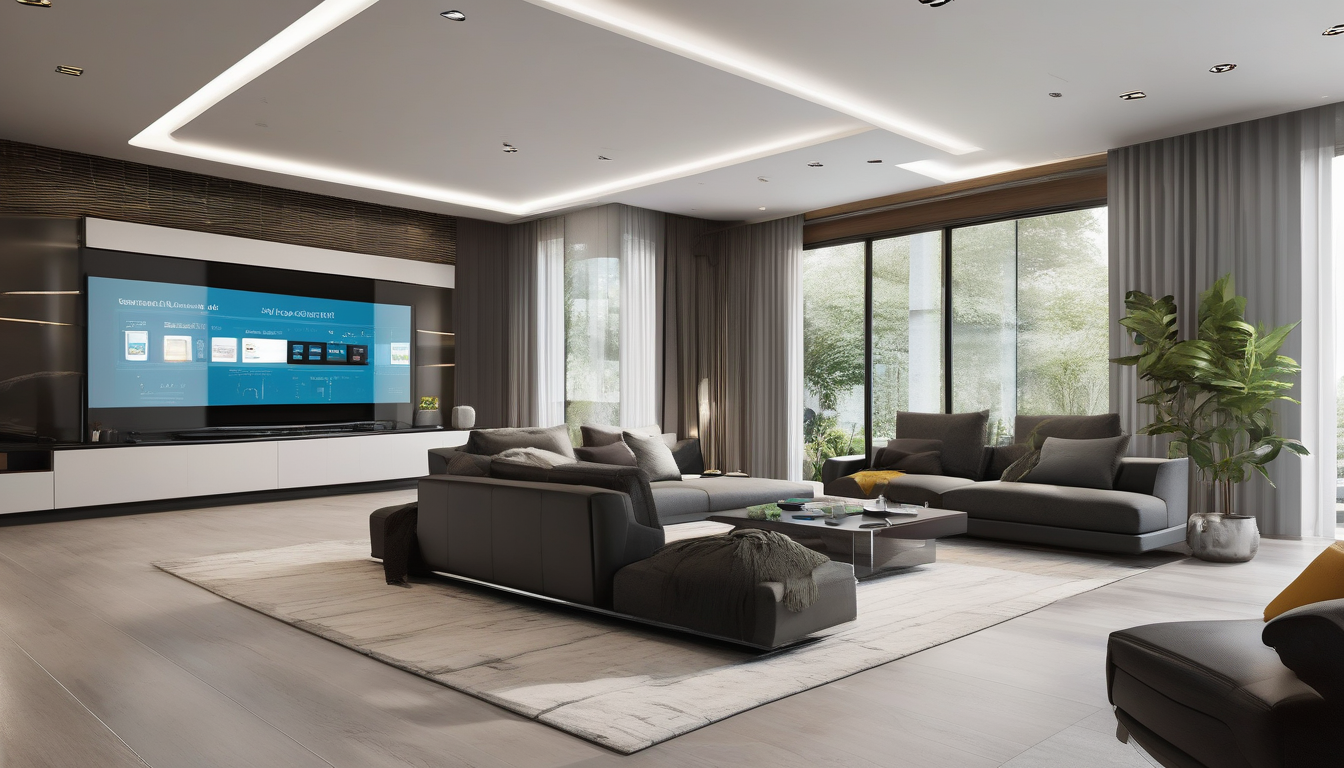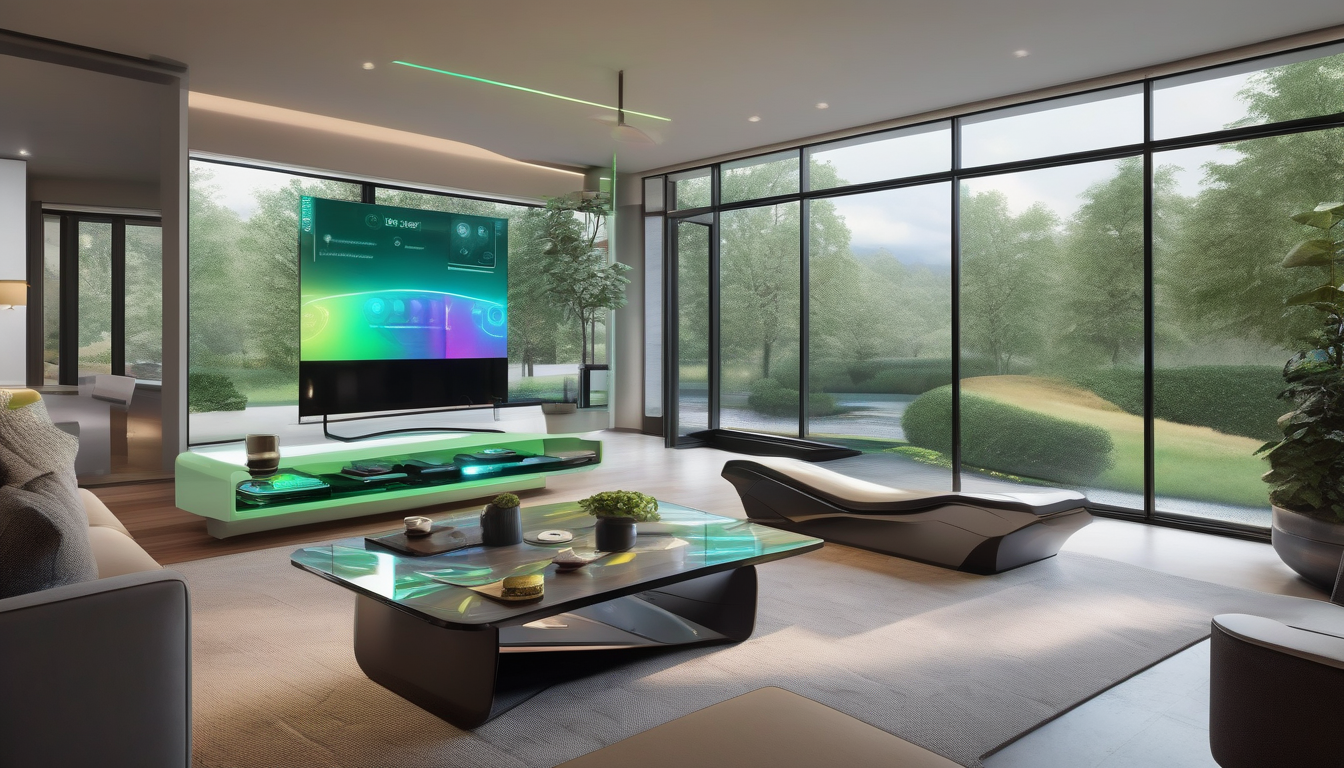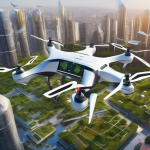The Evolution of Smart Homes: From Assistants to Fully Automated Living

The journey of smart homes is nothing short of fascinating. It all started as a simple idea: what if we could control our home devices remotely? Fast forward to today, and we find ourselves living in environments that not only respond to our commands but also anticipate our needs. This evolution has transformed our living spaces into fully automated ecosystems that enhance our comfort, security, and efficiency.
The concept of smart homes began with basic automation, introducing devices that could be controlled remotely. Early innovations like programmable thermostats and remote-controlled lights laid the groundwork for the sophisticated systems we enjoy today. Imagine being able to adjust your home’s temperature from your phone while you’re still at work—what a game changer!
Several key technologies have propelled the smart home revolution. The Internet of Things (IoT), artificial intelligence (AI), and voice recognition are at the forefront of this transformation. These technologies work in harmony to create seamless automation and user experiences that were once the stuff of science fiction.
At the heart of smart homes is the Internet of Things (IoT), which connects various devices and enables them to communicate with one another. This connectivity enhances the functionality and interconnectivity of smart home systems. For instance, your smart thermostat can learn your schedule and adjust the temperature automatically, making your home more comfortable while saving energy.
Smart sensors play a crucial role in monitoring home environments. These devices collect data on everything from temperature to motion, allowing for real-time adjustments that enhance energy efficiency and security. For example, a smart security system can alert you if it detects unusual movement when you’re away, keeping your home safe.
Home automation systems integrate various devices into a cohesive network. Imagine controlling your lights, thermostat, and security system all from one app! This centralized control not only simplifies our lives but also allows for more sophisticated automation, making modern living spaces truly smart.
AI takes smart home technology to the next level by learning user preferences and adapting accordingly. This means that your smart home can personalize experiences, from playing your favorite music when you arrive home to adjusting the lighting based on your mood. The responsiveness of these systems makes them feel like true companions in our daily lives.
Fully automated homes offer numerous advantages, from increased convenience to enhanced security. With smart technologies, homeowners can enjoy a level of comfort and control that was previously unimaginable. The ability to manage your home from anywhere, coupled with advanced security features, makes smart homes an appealing choice for modern families.
One of the most significant benefits of smart homes is energy efficiency. By optimizing energy use, homeowners can see substantial cost savings on their utility bills while also reducing their carbon footprint. Smart thermostats, for instance, can learn your habits and adjust heating and cooling accordingly, ensuring that energy is not wasted.
Security is a primary concern for homeowners, and smart homes offer advanced features that enhance safety. From surveillance cameras to smart locks, these technologies provide peace of mind. Imagine being able to check your security cameras from anywhere in the world or receiving instant alerts when someone approaches your front door.
The future of smart homes looks promising, with continuous advancements on the horizon. Emerging technologies such as 5G connectivity and machine learning are set to revolutionize the way we interact with our living spaces. As we look ahead, it’s clear that the evolution of smart homes is just beginning, and the possibilities are truly exciting.

The Birth of Smart Home Technology
The concept of smart homes didn’t just appear overnight; it evolved from a simple idea into a revolutionary concept that has transformed how we live. In the early days, home automation was limited to basic functions, like turning lights on and off remotely or controlling a thermostat from afar. This was essentially the dawn of smart home technology, where convenience started to meet innovation.
As technology progressed, the foundation for modern smart homes was laid with the introduction of devices that could be controlled via remote access. Imagine being able to adjust your home’s temperature while lounging on the beach or turning off the lights after you’ve already tucked into bed. This level of control was groundbreaking, but it was just the beginning.
During this period, the focus was primarily on creating devices that could perform specific tasks. For instance, early smart home devices included:
- Remote-controlled lights
- Smart plugs
- Basic security cameras
These innovations set the stage for more complex systems. The integration of wireless technology allowed these devices to communicate with one another, paving the way for what we now refer to as the Internet of Things (IoT). This interconnectedness made it possible for homeowners to manage multiple devices from a single platform, creating a more cohesive living experience.
Moreover, the rise of mobile technology played a significant role in the birth of smart home technology. With smartphones becoming ubiquitous, homeowners found it easier to control their devices on the go. This shift not only enhanced user experience but also increased the demand for more sophisticated systems that could learn and adapt to individual preferences.
In summary, the birth of smart home technology was marked by gradual advancements that combined convenience with connectivity. As we moved from simple remote controls to complex networks of devices, the groundwork was laid for the fully automated living environments we enjoy today. The journey has been exciting, and it’s just the beginning of what’s possible in the realm of smart homes.

Key Technologies Driving Smart Homes
The journey of smart homes is nothing short of a technological revolution, and at the heart of this transformation are several key technologies that have made modern living not just convenient, but also incredibly efficient and secure. Internet of Things (IoT), Artificial Intelligence (AI), and voice recognition are just a few of the driving forces behind this exciting evolution.
First up, let’s talk about the Internet of Things (IoT). Imagine a world where your refrigerator communicates with your grocery delivery service, or where your thermostat adjusts itself based on your daily routine. That’s IoT for you! It connects various devices within the home, allowing them to communicate and work together seamlessly. This interconnectedness is what makes smart homes truly ‘smart’. For instance, when you leave your home, your IoT-enabled security system can automatically lock the doors, turn off the lights, and even adjust the thermostat to save energy.
Another critical component of smart homes is the use of smart sensors and devices. These little gadgets are like the eyes and ears of your home, constantly monitoring the environment. They collect data on temperature, humidity, and even motion. This data is invaluable; it helps in optimizing energy usage, enhancing security, and improving overall comfort. For example, a smart thermostat can learn your preferences over time, adjusting the temperature based on your habits, which not only keeps you comfortable but also saves on energy costs.
Now, let’s dive into home automation systems. These systems integrate various smart devices into a cohesive network, allowing homeowners to control everything from lighting to security systems from a single app. The convenience of centralized control cannot be overstated. Imagine being able to set the mood for a movie night with just a tap on your smartphone—dim the lights, close the curtains, and even start the popcorn maker, all without getting off the couch!
Finally, we have Artificial Intelligence (AI). This technology takes smart homes to the next level by learning from user behaviors and preferences. AI can analyze your daily routines and adjust the home environment accordingly, making life easier and more enjoyable. For instance, if you typically wake up at 7 AM, your AI-powered system can start brewing coffee and warming up the shower at just the right time.
In conclusion, the integration of these technologies is not just enhancing our living spaces; it’s revolutionizing how we interact with our homes. As we move forward, the possibilities are endless, and the future of smart homes looks brighter than ever!
The Internet of Things (IoT)
The Internet of Things (IoT) is often hailed as the backbone of smart home technology, and for good reason. Imagine a world where your refrigerator can remind you to buy milk, your thermostat adjusts itself based on your daily routines, and your lights turn off automatically when you leave the house. This isn’t just a futuristic dream; it’s the reality created by IoT. By connecting various devices to the internet, IoT enables them to communicate with each other, making our homes more intelligent and responsive than ever before.
At its core, IoT consists of a vast network of devices embedded with sensors, software, and other technologies that allow them to exchange data. This interconnectivity is what transforms ordinary homes into smart living spaces. For instance, when you unlock your smart door lock, it can send a signal to your security system, notifying it to disarm. This seamless communication enhances not only convenience but also security.
Moreover, the data collected by these devices can be analyzed to provide insights into your daily habits. For example, smart thermostats learn your schedule and adjust temperatures accordingly, saving energy and reducing costs. This is particularly important in today’s world, where energy efficiency and sustainability are top priorities. By optimizing energy use, IoT devices help homeowners lower their utility bills while also contributing to a greener planet.
Let’s take a quick look at how IoT devices can be categorized based on their functions:
| Device Type | Function |
|---|---|
| Smart Thermostats | Regulate home temperature based on user preferences and schedules. |
| Smart Lighting | Adjust lighting based on occupancy and time of day. |
| Smart Security Cameras | Monitor home security and send alerts to homeowners. |
| Smart Appliances | Enhance kitchen efficiency by automating cooking and food storage tasks. |
As we continue to embrace IoT, the potential for creating smarter, more efficient homes is limitless. With every new device that connects to the internet, we step closer to a future where our homes not only respond to our needs but also anticipate them. The integration of IoT in smart homes is not just about convenience; it’s about creating a lifestyle that is innovative, efficient, and ultimately, more enjoyable.
Smart Sensors and Devices
In the realm of smart homes, are the unsung heroes that quietly work behind the scenes to create a seamless living experience. Imagine walking into your home, and the lights automatically adjust to your preferred brightness while your thermostat sets the perfect temperature. This is the magic of smart sensors at work! These devices are designed to monitor various aspects of your home environment, collecting data that informs your smart home system on how to respond to your needs.
Smart sensors come in various forms, each serving a unique purpose. For instance, motion sensors can detect when someone is present in a room, prompting lights to turn on or off accordingly. Temperature sensors help regulate heating and cooling systems, ensuring that you enjoy optimal comfort without wasting energy. Additionally, moisture sensors play a crucial role in preventing water damage by alerting homeowners to leaks or excessive humidity levels.
But how do these sensors enhance both energy efficiency and security? Let’s break it down:
- Energy Efficiency: By continuously monitoring conditions, smart sensors can optimize energy use. For example, they can adjust your heating system based on real-time data, reducing unnecessary energy consumption and ultimately lowering your utility bills.
- Enhanced Security: Smart sensors are integral to home security systems. They can detect unusual movements or sounds, alerting homeowners to potential intrusions. Coupled with smart cameras, they provide a comprehensive security solution that allows you to monitor your home from anywhere.
Moreover, these devices are not just about monitoring; they are about communication. They connect with your home automation system to create a cohesive network. For example, when a smoke detector senses smoke, it can trigger the lights to flash and send alerts to your smartphone, ensuring you are always in the loop, no matter where you are.
In conclusion, smart sensors and devices are pivotal in transforming ordinary houses into extraordinary smart homes. They bring a level of convenience and efficiency that makes modern living not just easier, but also safer and more sustainable. As technology continues to evolve, we can only expect these smart devices to become even more intuitive, further enhancing our living environments.
Home Automation Systems
Home automation systems are the backbone of modern smart homes, seamlessly integrating various devices into a cohesive network that enhances daily living. Imagine walking into your home after a long day, and with just a simple voice command, the lights dim, your favorite music starts playing, and the thermostat adjusts to your preferred temperature. This is not just a dream anymore; it’s the reality brought to life by sophisticated home automation systems.
These systems allow homeowners to control and monitor their environment remotely, providing unparalleled convenience and peace of mind. For instance, you can check your security cameras or lock your doors from your smartphone, no matter where you are. This level of control is not only about convenience; it significantly enhances security and energy efficiency, making it a win-win situation.
At the core of home automation systems are various components that work together to create a smart living experience. These include:
- Smart Hubs: The central unit that connects all smart devices, allowing them to communicate and be controlled from a single interface.
- Smart Lights: Lights that can be programmed to turn on and off at specific times or controlled remotely.
- Smart Thermostats: Devices that learn your heating and cooling preferences, optimizing energy use while keeping you comfortable.
- Smart Locks: Keyless entry systems that enhance security and allow for remote locking and unlocking.
Additionally, the integration of these systems can lead to significant energy savings. For example, when you leave home, the automation system can automatically turn off lights and adjust the thermostat, ensuring that energy is not wasted. This not only reduces your utility bills but also contributes to a more sustainable lifestyle.
As technology continues to evolve, the capabilities of home automation systems are expanding, making them more intuitive and user-friendly. With advancements in artificial intelligence and machine learning, these systems are beginning to anticipate our needs and preferences, creating a truly personalized living environment. In essence, home automation systems are not just about controlling devices; they are about enhancing the quality of life and making our homes smarter, safer, and more efficient.
Artificial Intelligence in Smart Homes
Artificial Intelligence (AI) is the secret sauce that makes smart homes not just automated, but intelligent. Imagine walking into your home after a long day, and the lights automatically adjust to your preferred brightness while your favorite playlist starts playing. Sounds like magic, right? But it’s all thanks to AI learning your habits and preferences over time.
AI systems in smart homes analyze data from various sources, allowing them to predict what you want before you even ask. For instance, if you typically turn on the coffee maker at 7 AM, your smart home will remember this and do it for you, ensuring you wake up to the smell of freshly brewed coffee. This kind of personalization transforms a simple living space into a tailored experience.
Moreover, AI enhances the security of smart homes. With features like facial recognition on smart cameras, your home can distinguish between familiar faces and strangers. This means that if an unknown person approaches your front door, you’ll receive an immediate alert on your smartphone. It’s like having a personal security guard who never sleeps!
To give you a clearer picture, let’s break down some key roles AI plays in smart homes:
- Predictive Analytics: AI learns from your behavior to anticipate your needs.
- Home Security: Advanced monitoring and alerts based on user recognition.
- Energy Management: AI optimizes energy usage based on your habits, reducing waste.
As we look to the future, the integration of AI in smart homes is only going to get better. With advancements in machine learning and natural language processing, your smart home will not only respond to commands but also engage in conversations, making it feel more like a living companion rather than just a collection of devices.
In conclusion, AI is revolutionizing the way we interact with our living spaces. It’s not just about convenience anymore; it’s about creating a home that understands you, ensuring that every moment spent at home is as comfortable and efficient as possible.

Benefits of Fully Automated Living
Imagine walking into your home after a long day, and the lights gently brighten, your favorite music starts playing, and the temperature adjusts to your preferred setting—all without you lifting a finger. This is the beauty of fully automated living! The benefits of smart homes extend far beyond mere convenience; they encompass enhanced security, energy efficiency, and even personalized experiences that cater to your lifestyle.
One of the most significant advantages of fully automated living is energy efficiency. Smart homes utilize advanced technologies to monitor and optimize energy consumption. For instance, smart thermostats learn your schedule and adjust heating or cooling accordingly, which can lead to substantial savings on utility bills. According to recent studies, homeowners can save up to 30% on energy costs simply by implementing smart home technologies. This not only benefits your wallet but also contributes to a reduced carbon footprint, making your home more environmentally friendly.
Another crucial aspect is improved security features. In today’s world, safety is a top priority for homeowners. Smart homes come equipped with advanced security systems, including surveillance cameras, motion detectors, and smart locks. These devices can send real-time alerts to your smartphone, allowing you to monitor your property from anywhere. Imagine being able to check in on your home while you’re on vacation or receiving instant notifications if someone attempts to enter your home. This peace of mind is invaluable.
Furthermore, the convenience that comes with automation cannot be overstated. With a simple voice command or tap on your smartphone, you can control everything from lighting to appliances. This level of control not only simplifies daily tasks but also enhances your overall quality of life. For example, you can set your coffee maker to start brewing as soon as your alarm goes off, or program your blinds to open gradually with the sunrise. It’s like having a personal assistant dedicated to making your life easier!
In summary, the benefits of fully automated living are profound and multifaceted. From energy savings and enhanced security to unparalleled convenience, smart homes are revolutionizing the way we live. As technology continues to advance, we can only imagine how much more integrated and intuitive our living spaces will become.
Energy Efficiency and Cost Savings
One of the most compelling reasons homeowners are embracing smart home technology is its remarkable ability to enhance energy efficiency and drive down costs. Imagine walking into your house, and as soon as you step through the door, the lights adjust to the perfect brightness, the thermostat sets itself to your ideal temperature, and your appliances run only when they’re needed. This isn’t just a dream; it’s the reality of modern smart homes.
Smart homes utilize a variety of technologies to monitor and optimize energy usage. For instance, smart thermostats learn your schedule and preferences, adjusting the temperature accordingly. This means no more wasting energy heating or cooling an empty house. According to recent studies, homeowners can save as much as 30% on their heating and cooling costs by using these intelligent systems.
Additionally, smart lighting systems can significantly cut down on electricity consumption. With features like motion sensors and timers, lights can turn off automatically when a room is unoccupied. This not only saves energy but also prolongs the lifespan of your bulbs. Imagine how much energy you could save by simply having lights that know when to turn off!
Furthermore, smart appliances are designed to operate at optimal times, often during off-peak hours when energy rates are lower. For example, a smart dishwasher can be programmed to run overnight, taking advantage of these lower rates. This not only saves money but also reduces strain on the electrical grid during peak times, contributing to a more sustainable environment.
| Smart Home Feature | Energy Savings |
|---|---|
| Smart Thermostat | Up to 30% on heating and cooling |
| Smart Lighting | Significant reduction in electricity usage |
| Smart Appliances | Cost savings during off-peak hours |
In conclusion, the integration of smart technology in homes not only enhances comfort but also leads to substantial cost savings and energy efficiency. By investing in these systems, homeowners can enjoy a more sustainable lifestyle while keeping their bills in check. So, why not take the plunge into the world of smart living? Your wallet and the planet will thank you!
Improved Security Features
When it comes to protecting our homes, security is more than just a priority—it’s a necessity. In today’s world, where threats can come from anywhere, smart homes have stepped up their game with a plethora of advanced security features. Imagine being able to monitor your home from anywhere in the world, or receiving instant alerts if something seems off. This is not just a fantasy; it’s the reality of modern smart home technology.
One of the standout features of smart home security systems is the integration of surveillance cameras. These aren’t your average cameras; they come equipped with high-definition video, night vision, and motion detection capabilities. You can easily access live feeds from your smartphone, ensuring you never miss a moment. In fact, many systems allow you to set up alerts that notify you immediately if any unusual activity is detected, providing peace of mind when you’re away.
In addition to cameras, smart locks have revolutionized how we think about home security. Forget about fumbling for keys or worrying about lost ones. With smart locks, you can control access to your home with your smartphone or even through voice commands. Some models allow you to create temporary access codes for guests, which can be a game-changer for those who frequently have visitors. This technology not only enhances security but also adds a layer of convenience that traditional locks simply can’t match.
Furthermore, the integration of smart sensors plays a vital role in enhancing home security. These sensors can detect everything from motion to glass breaking, alerting homeowners to potential intrusions. For instance, if a window is shattered, the system can trigger an alarm and send an immediate notification to your phone. This proactive approach ensures that you’re always one step ahead of any potential threats.
To summarize, the improved security features in smart homes are designed not just to deter intruders but to give homeowners a sense of control and safety. The combination of surveillance cameras, smart locks, and advanced sensors creates a comprehensive security system that adapts to your lifestyle. As technology continues to evolve, we can only expect these features to become more sophisticated, making our homes safer than ever before.

The Future of Smart Homes
The future of smart homes is not just bright; it’s positively dazzling! As technology continues to evolve at lightning speed, we can expect smart homes to become even more integrated into our daily lives. Imagine waking up in a home that knows your routine better than you do. With advancements in artificial intelligence and machine learning, future smart homes will be capable of predicting your needs and adjusting accordingly.
One of the most exciting prospects is the development of self-learning systems. These systems will analyze your habits and preferences, allowing them to automate tasks without any input from you. For instance, your home could automatically adjust the temperature based on your comfort level or even suggest meals based on your dietary preferences. This level of personalization will transform how we interact with our living spaces.
Moreover, we can expect a surge in the use of renewable energy sources within smart homes. With the integration of solar panels and energy storage systems, homes will not only be energy-efficient but could also become energy producers. Imagine a world where your home generates its own power and sells excess energy back to the grid! This not only reduces carbon footprints but also promotes sustainability.
As we look ahead, security will remain a top priority. Future smart homes will feature advanced security systems that utilize facial recognition and biometric sensors, making unauthorized access nearly impossible. These innovations will provide homeowners with peace of mind, knowing that their homes are protected by cutting-edge technology.
Furthermore, the rise of 5G technology will enhance connectivity among devices. This means faster response times and more reliable communication between your smart gadgets. Imagine controlling your entire home with just your voice or a simple tap on your smartphone, all happening in real-time without any lag.
In conclusion, the future of smart homes is not just about convenience; it’s about creating an environment that adapts to our needs, improves our quality of life, and promotes sustainability. As we embrace these advancements, we are not merely enhancing our living spaces but also paving the way for a more intelligent and connected world.
Frequently Asked Questions
- What is a smart home?
A smart home is a living space equipped with devices that can be controlled remotely through a smartphone, tablet, or voice commands. These devices often work together to enhance convenience, security, and energy efficiency.
- How do smart home devices communicate with each other?
Smart home devices typically communicate via the Internet of Things (IoT), which connects them through a network. This allows devices to share data and work together seamlessly, creating an integrated home automation system.
- What are the benefits of having a fully automated home?
Fully automated homes offer numerous benefits, including increased convenience, enhanced security, and improved energy efficiency. Homeowners can enjoy features like remote monitoring, smart lighting, and automated temperature control, all contributing to a more comfortable living environment.
- Can I control my smart home devices when I’m away?
Absolutely! Many smart home systems allow you to control devices remotely through mobile apps. Whether you’re at work or on vacation, you can monitor and manage your home’s functions from anywhere.
- Are smart homes energy-efficient?
Yes, smart homes are designed to optimize energy use. Automated systems can adjust heating, cooling, and lighting based on your habits, leading to significant cost savings on utility bills and a reduced carbon footprint.
- What security features are available in smart homes?
Smart homes can include advanced security features such as surveillance cameras, smart locks, and motion detectors. These devices can send alerts to your smartphone and allow you to monitor your home in real-time, enhancing overall safety.
- What technologies are driving the evolution of smart homes?
Key technologies include IoT, artificial intelligence (AI), and voice recognition. These innovations work together to create a seamless user experience, enabling smart homes to learn user preferences and automate tasks effectively.
- What does the future hold for smart homes?
The future of smart homes looks bright, with continuous advancements in technology. Emerging trends may include more sophisticated AI, enhanced interconnectivity, and even greater focus on sustainability and energy efficiency.













